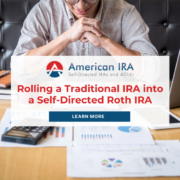What are the Differences between a Self-Directed Roth IRA and a Roth 401(k)?
A Self-Directed Roth IRA and a Roth 401(k) have some similarities. With both types of accounts, you make your contributions after you have paid the taxes on them. And, when you reach the age of 59 ½, you can take out your earnings without paying additional taxes.
But aside from a few parallels, there are significant differences between the two. While you are allowed to have both a Self-Directed Roth IRA and a Roth 401(k) at the same time, your employer must offer a Roth 401(k) for you to participate.
Take a look at some of the other differences so you can decide which plan works best for you:
Contribution and income limits
Whether it’s a Roth or traditional 401(k), the contribution limits are much higher than the IRA. In 2019, employees will be allowed to save up to $19,000 for the year. Workers over 50 may save up to $25,000. There are no income limits for the 401(k).
Roth and Traditional IRA contributions are limited to $6,000 or the amount of earned income, whichever is less. Those over 50 may set aside $7,000. There are income limitations, however, on Self-Directed Roth IRA contributions for 2019. If your modified adjusted gross income is $203,000 or more for married couples filing jointly or $137,000 or more for single filers, you are not allowed to contribute.
Distributions are handled differently
A Self-Directed Roth IRA account can continue forever, and there are no required minimum distributions as with Traditional IRAs. The Roth can also be passed along through generations, and it continues to accumulate free earnings for each generation.
A Roth 401(k) is treated differently. Distributions from a Roth 401(k) account must begin by age 70 ½ or when the account holder retires, whichever comes later. If you want to continue getting tax-free savings, rolling over to a Self-Directed Roth IRA is an option to consider.
Withdrawals from both the Self-Directed Roth IRA and the Roth 401(k) are tax-free as long as the accounts were held for at least five years, the distributions were made because of disability or death, or the account holder has reached the age of 59 ½.
Also, with a Self-Directed Roth IRA, you are allowed to withdraw up to $10,000 to buy or build a first home, without paying taxes and the 10 percent early withdrawal penalty, even if you are under age 59½.
Your employer can match your Roth 401(k) contributions
In addition to having higher contribution limits than Self-Directed Roth IRAs, the Roth 401(k) has another distinct advantage: Your employer can match any contributions you make up to a certain percentage. It’s free money from your employer that’s on top of your elective deferrals.
One caveat: Your employer’s match will be deposited into a traditional 401(k). Since you never receive the employer’s match, it cannot be completed on an after-tax basis. For that reason, the company match must be applied to a traditional 401(k).
You will have more investment options in a Roth IRA
Employees generally have little or no control over the investment choices that an employer’s Roth 401(k) plan offers. And those options are minimal most of the time. Those who hold a Self-Directed Roth IRA, on the other hand, will have greater control and more investment opportunities from which to choose.
And when retirement savers open a Self-Directed Roth IRA, they give themselves a virtually unlimited selection that includes alternative assets such as real estate, precious metals, private stock, and private lending.
Remember, even if you have a 401(k) plan through your employer, you may open and contribute to a Roth or traditional Self-Directed IRA. Interested in learning more about Self-Directed IRAs, download our free e-guide. Contact American IRA, LLC at 866-7500-IRA (472) or visit us online at www.AmericanIRA.com.






